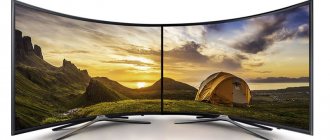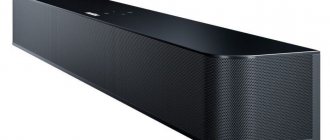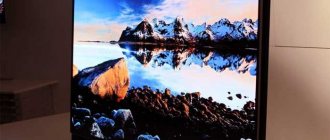Yes, at this point you can no longer argue with this: you do not need to allocate a separate room in your apartment for a home theater - this especially applies to using a projector. TVs with truly large flat screens are becoming more affordable every year, but projectors, as before, can display a much larger image for the same money. The market is changing, but the main question remains the same - actually, what should you choose: a large TV or a projector? This material will try to answer that.
Subscribe to our Zen
Image Size
In this particular case, we can speak very honestly - yes, size really matters. The more, the better - this rule works great if you have enough free space on your wall. It makes no difference why exactly you need a TV or projector: you want to watch movies with it, you plan to painstakingly play through your favorite games, you are thinking of watching traditional television programs - in all these cases, a larger image size greatly simplifies the consumption of content.
Of course, a projector makes it possible to achieve a much larger picture for much less money. However, it is also important to keep in mind that when using it, the image size can be changed as desired: if you move the device away from the screen, the image will be larger, if you move it closer, it will be smaller. The range of image sizes is also determined by the optical focusing ring. If you plan to install the projector in a small room, it makes sense to place it closer to the wall so as not to overdo it with the size - for a large room you need to do the opposite maneuver.
Nothing like that can be said about a TV with any large screen. Firstly, in terms of the area of the picture, it will definitely cost much more. Secondly, it obviously has a fixed size that cannot be made smaller or larger - this is especially critical when the location of the gadget changes.
Winner: when it comes to image size, it is the projector that takes the lead 100%, and this outcome was expected.
4K projector instead of TV
If you want to answer the question in the title of the text, you should consider the possible options for using a projector. In many cases, it takes on the role of a home theater that will give movie nights a whole new meaning.
The equipment in question is also ideal for gaming, especially when we need a large diagonal. The feeling of having to buy a projector will be puzzling if you want to use it to play regular TV programs. Due to their high price (they are 4K devices after all), this will not be a good deal.
Image quality
The main problem with projectors has always been the image quality they were ultimately capable of, both in terms of contrast levels and color accuracy. The first indicator can become significantly worse due to ambient lighting or insufficient quality of the projection surface. However, it's also important to keep in mind that direct sunlight can create glare on your TV screen - which I'm sure you'll agree is much more annoying.
Yes, color accuracy for large projection displays is still a major challenge. LCD projectors usually do a much better job of getting the colors right, but they also tend to create a screen door effect, which is clearly demonstrated in the image above. DLP projectors use a special rotating wheel to create shades - they are devoid of both the disadvantages and advantages of the previous solution: they have noticeably less accurate colors, but the annoying inter-pixel distance is not visible.
Screen door effect is a visual artifact of displays where thin lines separating pixels or sub-pixels become visible in the displayed image. This can be seen in images from digital projectors and conventional displays when zoomed in or at close range. (Wikipedia)
LCD and LED TVs with large screens also have separate pixels. However, at this stage of technology development, manufacturers take into account the ratio of display dimensions and the number of dots on them, so that the latter have a minimum size. This is why the screen door effect does not occur until you view the picture from a distance of several centimeters. In ordinary life, nothing like this usually happens, so TV is much preferable in this regard.
Winner: In this round, the big screen TV wins - it handles colors much better and doesn't create the effect of a screen door.
Terms of Use
Projectors can be divided into three classes according to the type of premises in which they are used.
The bulk of projectors are devices designed for use in offices, auditoriums, classrooms and other areas where light is usually present
. The goal of such projectors is to produce a good image, regardless of artificial lighting. Of course, the lights can be turned off, but the ability of projectors for offices and educational institutions to produce high brightness has become a mandatory requirement. Such projectors are often called “mobile” because they are quite easy to move from place to place. Also for similar purposes, devices are offered, classified according to the types “projectors for education” or “projectors for business”
The second type of projectors are home theater projectors
, designed to work when the lights are off. In these conditions, projectors do not require high brightness, but accurate color reproduction and high contrast levels are highly visible and highly valued.
The third class is installation projectors
, having very high brightness and large dimensions and weight. Such projectors are used in large rooms such as conference rooms, assembly and concert halls, as well as for open-air installations. This type of projector is capable of giving you image brightness that is far beyond the capabilities of conventional “office” projectors.
This may be a somewhat simplistic view, but when choosing a projector, you should first of all decide which of the above-mentioned classes the projector you need belongs to. So, the first parameter you should pay attention to is brightness.
Location and Portability
The vast majority of modern projectors support both forward and rear projection. The latter can be a great option because it makes it possible to hide the gadget behind the screen. Many projectors need to be placed a couple of meters away from the surface on which the image needs to be transmitted. However, it's also worth considering that there are more than enough short-throw projectors on the market today that can be placed just a few centimeters away - these would feel great right on a bedside table near the wall.
As for moving to any room or another room altogether, a projector in this regard looks like a noticeably more preferable device. By its very nature, it is a portable device that can be used to watch movies and play your favorite games both inside and outside the home. Yes, imagine that you have the opportunity to quickly arrange a movie show in the fresh air, and for this you only need to take it outside and point it at an improvised screen - a light wall or even a white sheet. In this case, there will be much more hassle with a large TV - especially if it hangs on the wall.
Winner: Projectors were originally designed with relatively mobile use in mind, so their location can be changed noticeably more easily.
Networking capabilities
By connecting a projector to an organization’s network, you can solve two problems: the first is remote control of projectors and monitoring their status using special software. The second is to use the projector as a shared projector and transfer images to it via the network.
It is also possible to project via wireless network from mobile devices. For more information, see “Network capabilities of Epson projectors.” Another option for connecting mobile devices is via the HDMI interface with MHL support. This connection option allows you to duplicate the screen of a mobile device on the projector (if it supports MHL).
Permission and cost
Today, the industry standard is 4K resolution. Working with it within a projector is far from the easiest task. Yes, there are devices that natively use this value, but their cost is usually at an extremely high level. If we are talking about more or less affordable gadgets, you should expect no more than 1080p from them, which needs to be stretched over a fairly large area.
However, even relatively affordable projectors can very quickly change the position of the image on the surface in order to create the effect of using 4K - this happens so quickly that the human eye cannot see the difference. No, seriously - if you show you a picture from a projector that uses this shift, as well as an image in native 4K resolution, you are unlikely to see a real difference. However, as the projection area increases, it will become more and more obvious.
The situation on the TV market is somewhat different. Today, models with 4K resolution can already be called relatively inexpensive - especially if their size does not exceed 65 inches. Of course, if you look at larger options, their prices will rise rapidly - up to incredibly expensive models of 85 inches and larger. Why, there are also TVs on the market with a larger diagonal - up to 120 inches. However, their cost is so high that there is a choice: buy something similar or a brand new sports car for the same money.
It is also important to note that the development of televisions is still going much faster. While projectors are still heading towards 4K resolution, flat-panel 8K panels are starting to appear on the market.
Winner: of course, in this round, it is TVs that take the lead with an obvious advantage - yes, with a significant increase in diagonal, they become too expensive, but projectors with 4K resolution are also not cheap today.
Refresh rate and games
The minimum image refresh rate that can be found today is 30 Hz - this is extremely low for normal use. To enjoy watching movies and TV series, you want 60 Hz, and to play your favorite games, 120 Hz, or better yet, 144 Hz or more.
Of course, most projectors will not be able to cope with such a task - especially in an adequate price segment. Given the shift to achieve 4K resolution, it's quite difficult for them to even get to 60Hz. However, there are already plenty of TVs on the market that comply with the HDMI 2.1 standard - it involves using 8K resolution at 60 Hz or 4K at 120 Hz. If you add to this a modern console like the Xbox Series X, Xbox Series S or Playstation 5, which will provide the opportunity to fully unleash 4K gaming at 120 Hz, the question of choice will disappear by itself.
The higher the frame rate and refresh rate, the smoother on-screen movements will be. If you haven't used 120Hz before, you probably won't realize what you're missing, but after 120Hz, going back to 60Hz is really difficult.
By the way, another important feature of HDMI 2.1 is the variable refresh rate, which is supported by new generation game consoles and some modern TVs. It allows the output device to work directly with the device that renders the image. This is necessary in order to avoid the so-called screen tearing, which is clearly visible in the image above.
Screen tearing occurs when the refresh rate of the screen and the frame rate that is sent to it do not match. As a result, parts of the image from several frames at once may appear on the TV - this happens literally for an instant, but the effect is still unpleasant. Variable frame rate corrects this misunderstanding. In other words, if the console can't handle more than 80Hz at a given time, the TV won't attempt to run at 120Hz either. Of course, projectors are still very far from such technologies.
Winner: yes, projectors lose this round by an obvious margin - this is due to the low frame rate at which the vast majority of them can operate.
Color brightness
The topic of brightness doesn't end there, as projectors can be built on different technologies and produce white in different ways. There are three-matrix
and
single matrix
projectors. All Epson projectors belong to the first group (3LCD technology, by definition, is three-matrix).
The difference between these two types of projectors is that three-matrix projectors are able to split the white light of the lamp into red, green and blue, and then “assemble” it together to produce a finished image, while single-matrix projectors have to work with one color at a time. each time losing other colors, and therefore brightness.
Projector diagram with three matrices:
Diagram of single matrix projection technology:
As a result, with the same lamp power, a three-matrix projector, “separating and collecting” light, gives higher brightness than a single-matrix projector, “throwing out” certain wavelengths of light in turn (because the law of conservation of energy has not been canceled).
To formally achieve maximum brightness at the level of three-matrix models, single-matrix projectors can enhance white light at the expense of weakening colors . Therefore, in order to clarify the “maximum brightness” parameter, manufacturers of three-matrix projectors (not only 3LCD) use the concept of “color brightness”. If the color brightness is equal to the maximum, and this is the case with all three-matrix projectors, then the projector will give you a color image adequate to its maximum brightness across all channels: R, G and B.
If the color brightness is below the maximum, the projector will give you a black and white image at one brightness and a color image at another brightness. When displaying text, such a projector can work like a projector with a brightness of 3000 lumens, and when displaying a color cartoon or your company logo - like a projector with a brightness of, say, 1000 lumens! When simultaneously displaying a bright colored and bright white object on the screen (blue sky and clouds, white background and logo, etc.), there will be a strong imbalance in brightness between them. As a rule, skin tones at low color brightness look unnatural - too dark, with a brownish tint. It might look something like this:
In other words, there are two types of brightness - color
and
black and white
. If the black and white brightness does not match the color brightness, then to obtain a high-quality image, the projector's brightness must be reduced to its color brightness, which can be done through various settings in the projector menu. The advantage of Epson projectors and 3LCD technology is the fact that their maximum brightness is always equal to color. This allows you to get high-quality color images with vibrant colors even in the brightest projector mode. This does not change the fact that color reproduction in the brightest mode is less accurate, but the bright mode is needed when working in a lit room, where image quality already suffers. High color brightness allows you to use 100% of the projector's light output without any compromise.
You can read more about color brightness here or here. Believe me, color brightness is not a parameter “invented by marketers,” but a characteristic that really allows you to evaluate before purchasing a device what brightness indicators you can expect from it when outputting real video material.
Summing up
Of course, especially after reading the last point, you might think that the choice in favor of large screen TVs is obvious. However, with projectors everything is not as bad as it might seem, and the impressions from using modern models will be as positive as possible.
If you are an avid gamer, then you should definitely not consider a projector to get the most pleasant gaming experience. It is better to choose a TV that supports HDMI 2.1, variable frame rate, and a refresh rate of at least 120 Hz.
For everyone else who spends more time watching movies and television shows, as well as modern series, it makes sense to consider projectors, among other things. Yes, they may lag behind TVs in some technologies, but the most important ones appear on them very quickly. Judging by the movement of the market, both affordable models with 4K resolution and top-end models with 8K resolution and a frame refresh rate of 120 Hz will soon appear on it. The new generation of gaming consoles looks set to help make this happen sooner rather than later.
This is a translation of a Review Geek article.










